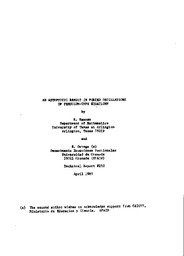
ATTENTION: The works hosted here are being migrated to a new repository that will consolidate resources, improve discoverability, and better show UTA's research impact on the global community. We will update authors as the migration progresses. Please see MavMatrix for more information.
Show simple item record
| dc.contributor.author | Kannan, R. | en |
| dc.contributor.author | Ortega, R. | en |
| dc.date.accessioned | 2010-06-08T16:49:23Z | en |
| dc.date.available | 2010-06-08T16:49:23Z | en |
| dc.date.issued | 1985-04 | en |
| dc.identifier.uri | http://hdl.handle.net/10106/2378 | en |
| dc.description.abstract | **Please note that the full text is embargoed** ABSTRACT: The forced pendulum-type equation is given by [see pdf for notation] where [see pdf for notation] is continuous and T-periodic and p(t) is[see pdf for notation] -periodic. When g(x) = a sin x, a > 0, we obtain the classical pendulum equation. The question of existence of [see pdf for notation] periodic solution of (1.1) for a given p(t) has been studied recently in [1], [3], [5] (cf. [4] for an extensive bibliography).
Throughout this paper we denote by [see pdf for notation] the average of [see pdf for notation]. Some of the existence literature obtains sufficient conditions on the magnitudes of [see pdf for notation] and [see pdf for notation] in order that (1.1) have [see pdf for notation]- periodic solutions. A second category of results in the literature involves studying the problem (1.1) as characterizing the p(t) that are in the range of the operator [see pdf for notation]acting on [see pdf for notation]- periodic functions. | en |
| dc.language.iso | en_US | en |
| dc.publisher | University of Texas at Arlington | en |
| dc.relation.ispartofseries | Technical Report;232 | en |
| dc.subject | Forced pendulum-type | en |
| dc.subject | Periodic solutions | en |
| dc.subject | Periodic functions | en |
| dc.subject.lcsh | Mathematics Research | en |
| dc.subject.lcsh | Trigonometry | en |
| dc.title | An Asymptotic Result in Forced Oscillations of Pendulum-Type Equations | en |
| dc.type | Technical Report | en |
| dc.publisher.department | Department of Mathematics | en |
Files in this item
- Name:
- MathTechReport232.pdf
- Size:
- 479.8Kb
- Format:
- PDF
- Description:
- PDF
This item appears in the following Collection(s)
Show simple item record


